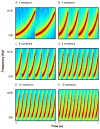The easy-to-hard effect in human (Homo sapiens) and rat (Rattus norvegicus) auditory identification
- PMID: 18489229
- PMCID: PMC2664539
- DOI: 10.1037/0735-7036.122.2.132
The easy-to-hard effect in human (Homo sapiens) and rat (Rattus norvegicus) auditory identification
Abstract
The authors examined whether progressively training humans and rats to perform a difficult auditory identification task led to larger improvements than extensive training with highly similar sounds (the easy-to-hard effect). Practice improved humans' ability to distinguish sounds regardless of the training regimen. However, progressively trained subjects were more accurate and showed more generalization, despite significantly less training with the stimuli that were the most difficult to distinguish. Rats showed less capacity to improve with practice but still benefited from progressive training. These findings indicate that transitioning from an easier to a more difficult task during training can facilitate, and in some cases may be essential for, auditory perceptual learning. The results are not predicted by an explanation that assumes interaction of generalized excitation and inhibition but are consistent with a hierarchical account of perceptual learning in which the representational precision required to distinguish stimuli determines the mechanisms engaged during learning.
PsycINFO Database Record (c) 2008 APA, all rights reserved.
Figures







Similar articles
-
Temporal dynamics in auditory perceptual learning: impact of sequencing and incidental learning.J Exp Psychol Learn Mem Cogn. 2013 Jan;39(1):270-6. doi: 10.1037/a0028647. Epub 2012 May 28. J Exp Psychol Learn Mem Cogn. 2013. PMID: 22642235 Free PMC article.
-
Transfer of auditory perceptual learning with spectrally reduced speech to speech and nonspeech tasks: implications for cochlear implants.Ear Hear. 2009 Dec;30(6):662-74. doi: 10.1097/AUD.0b013e3181b9c92d. Ear Hear. 2009. PMID: 19773659 Free PMC article.
-
Sensory noise explains auditory frequency discrimination learning induced by training with identical stimuli.Atten Percept Psychophys. 2009 Jan;71(1):5-7. doi: 10.3758/APP.71.1.5. Atten Percept Psychophys. 2009. PMID: 19304592 Free PMC article.
-
Auditory perceptual learning and changes in the conceptualization of auditory cortex.Hear Res. 2018 Sep;366:3-16. doi: 10.1016/j.heares.2018.03.011. Epub 2018 Mar 12. Hear Res. 2018. PMID: 29551308 Review.
-
Toward a neurophysiological theory of auditory stream segregation.Psychol Bull. 2007 Sep;133(5):780-99. doi: 10.1037/0033-2909.133.5.780. Psychol Bull. 2007. PMID: 17723030 Review.
Cited by
-
Relationship between perceptual learning in speech and statistical learning in younger and older adults.Front Hum Neurosci. 2014 Sep 1;8:628. doi: 10.3389/fnhum.2014.00628. eCollection 2014. Front Hum Neurosci. 2014. PMID: 25225475 Free PMC article.
-
Sound Localization Ability in Dogs.Vet Sci. 2022 Nov 8;9(11):619. doi: 10.3390/vetsci9110619. Vet Sci. 2022. PMID: 36356096 Free PMC article.
-
Cortico-Hippocampal Computational Modeling Using Quantum Neural Networks to Simulate Classical Conditioning Paradigms.Brain Sci. 2020 Jul 7;10(7):431. doi: 10.3390/brainsci10070431. Brain Sci. 2020. PMID: 32645988 Free PMC article.
-
Temporal dynamics in auditory perceptual learning: impact of sequencing and incidental learning.J Exp Psychol Learn Mem Cogn. 2013 Jan;39(1):270-6. doi: 10.1037/a0028647. Epub 2012 May 28. J Exp Psychol Learn Mem Cogn. 2013. PMID: 22642235 Free PMC article.
-
Predicting favorable and unfavorable consequences of perceptual learning: worsening and the peak shift.Exp Brain Res. 2017 Apr;235(4):1233-1245. doi: 10.1007/s00221-016-4866-3. Epub 2017 Feb 11. Exp Brain Res. 2017. PMID: 28190080
References
-
- Ahissar M, Hochstein S. Task difficulty and visual hierarchy: reverse hierarchies in Sensory processing and perceptual learning. Nature. 1997;387:401–406. - PubMed
-
- Ahissar M, Hochstein S. The spread of attention and learning in feature search: Effects of target distribution and task difficulty. Vision Research. 2000;40:1349–1364. - PubMed
-
- Anderson JR, Corbett AT, Koedinger KR, Pelletier R. Cognitive tutors: Lessons learned. The Journal of the Learning Sciences. 1995;4:167–207.
-
- Baker RA, Osgood SW. Discrimination transfer along a pitch continuum. Journal of Experimental Psychology. 1954;48:241–246. - PubMed

